from the floor of the Alboran Sea Basin, Western Mediterranean
![]()
![]()
by
Soto, J. I.
Instituto Andaluz de Ciencias de la Tierra & Departamento de Geodinámica, C.S.I.C.-Universidad de Granada, Facultad de Ciencias, Campus Fuentenueva s/n, 18071-Granada, Spain.and Platt, J. P.
Department of Geological Sciences, University College London, Gower Street, London WC1E 6BT, U.K.Abstract
The metamorphic basement beneath the Alboran Sea, a Neogene extensional basin drilled during ODP Leg 161 (Site 976), consists of high-grade pelitic schist overlying migmatitic pelitic gneiss. Inferred assemblages in the high-grade schist evolved from garnet+staurolite+biotite+muscovite+ plagioclase (Assemblage 1) to biotite+sillimanite+K-feldspar+plagioclase±garnet (Assemblage 2) to andalusite+biotite+K-feldspar+plagioclase (Assemblage 3). In the gneiss, which shows abundant migmatitic textures, the present assemblage is biotite+andalusite+sillimanite+muscovite+ cordierite+K-feldspar+plagioclase±garnet. Phase relations and thermobarometric calculations suggest that the high-grade schist experienced decompression accompanied by heating from about 500°C at 10.5 kbar through 600±30°C at 6-7 kbar (Assemblage 1), and thence to 650-700°C at 3-4 kbar (Assemblage 2), followed by cooling through 500-600°C at 2 kbar or less (Assemblage 3). Peak temperature and melting occurred under low-pressure conditions. The widespread disequilibrium and overstepping of metamorphic reactions suggests that decompression was rapid. The P-T evolution is consistent with metamorphism in a late orogenic extensional basin, and suggests the existence of an external source of heat, probably indicating the complete removal of lithospheric mantle beneath the extending region.
Journal of Petrology, 1999, vol. 40, no. 1, (in press).
Here you will find the principal figures of the paper
with a simplified figure caption (for more details see the paper). I have
included a coloured version of the garnet zoning maps, which appear as
black-and-white images in the paper.
Figure 1. Location
of Ocean Drilling Program (ODP)-Site 976 in the West Alboran Sea basin,
with a schematic geological map of the surrounding Betic Cordillera and
Rif mountain chains. The metamorphic basement high around Site 976 shown
in shading is similar to the outcropping metamorphic complexes of the Alboran
Domain (Alpujarride Complex). Bathymetry contour interval is 200 m. AI:
Alboran Island.
Figure 2. Lithological columns of the metamorphic basement cored by ODP-Leg 161. Recovered intervals are shown in black in the recovery column.
Figure 5. Selected textural relationships in the high-grade schist (mineral abbreviations after Kretz, 1983; and Fib= fibrolite). (f) Relict staurolite preserved in a large andalusite porphyroblast. Staurolite is partially transformed to hercynite (Spl). Andalusite grows over the S2 foliation in the matrix, which is defined by a fine intergrowth of fibrolite and K-feldspar. Notice the minor occurrence of plagioclase surrounding the K-feldspar. Backscattered electron image. [1024 x 1024 pixels].
Figure 6. Garnet porphyroblast partially replaced by syn-D2 fibrolite, biotite, and K-feldspar, and post-D2 andalusite, biotite, and K-feldspar. Notice in (right) the late growth of muscovite in the presence of andalusite. Backscattered electron images. [(left) 1024 x 1024 pixels and (right) 512 x 512 pixels].
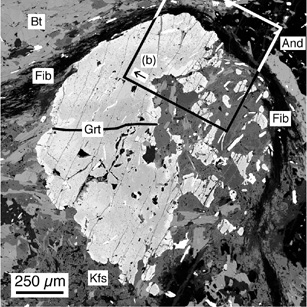 |
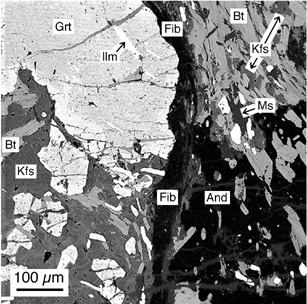 |
Figure 8. Backscattered electron image (a) and X-ray composition
maps of a garnet I porphyroblast from sample 76B. Arrows point to the irregular,
sharp boundary between the garnet I core and the garnet II overgrowth,
which correlates also with discontinuities in composition maps. [1024 x
1024 pixels, beam size= 1 µm, 3 µm/pixel, Faraday cup current=
25 nA, dwell time= 30 ms/pixel].
Ca X-Ray map
Fe X-Ray map
Mg X-Ray map
Figure 9. Backscattered electron image (a) and X-ray composition maps of a garnet I porphyroblast from sample 28. Arrows point to the irregular, sharp boundary between the garnet I core and the garnet II overgrowth, which correlates also with discontinuities in composition maps. [512 x 512 pixels, beam size= 1 µm, 5 µm/pixel, Faraday cup current= 25 nA, dwell time= 100 ms/pixel].Mn X-Ray map
Ca X-Ray map
Fe X-Ray map
Mg X-Ray map
Mn X-Ray map
Figure 10. Backscattered electron image (a) and X-ray
composition maps of a garnet II porphyroblast from sample 61. [1024 x 1024
pixels, beam size= 1 µm, 3 µm/pixel, Faraday cup current= 25
nA, dwell time= 30 ms/pixel].
Ca X-Ray map
Fe X-Ray map
Mg X-Ray map
Mn X-Ray map
Figure 16. Selected textural relationships in granite rocks:
(b)
Zoned plagioclase phenocryst surrounded by K-feldspar and corresponding
X-ray composition maps (left: Na and right: K). Dark areas
in the K-feldspar are small patches of Ab-rich plagioclase. Both feldspars
are replaced by a fine intergrowth of white mica and sericite with needle-like
quartz (in black). Backscattered electron image [512 x 512 pixels; sample
43].
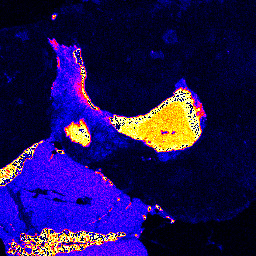 |
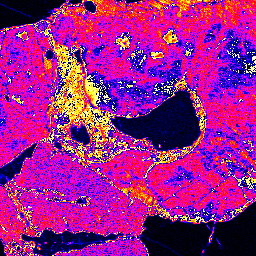 |
Figure 20. P-T diagrams showing composition (expressed as mole
fractions) and abundance (expressed as molar proportions of the phases)
isopleth contours corresponding to the assemblages St-in, St-out, Kfs-in,
and Crd-in, in the KNaCaFMASH system. Dashed portion of the P-T path shows
approximate P-T conditions along the prograde trajectory of the high-grade
schist based on zoning patterns of garnet I porphyroblasts. Calculations
have been done using the Gibbs method of Spear et al. (1982) and Spear
(1988, 1993), and the thermodynamic database of Berman (1988).
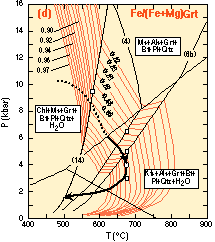 |
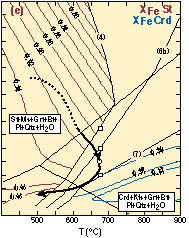 |
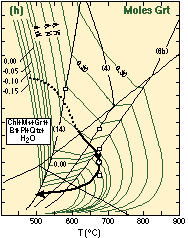 |
Figure 21. P-T path for the high-grade schist of the Alboran
basement, and approximate melting conditions in the gneiss (pink area).
The P-T stability fields for the different assemblages are shown in orange-coloured
areas, corresponding to Grt I core, Grt I rim (Assemblage 1), Grt II which
is equivalent to the D2 deformation event (Assemblage 2), and And+Ms (Assemblage
3). P-T grid composed from Spear & Cheney (1989) KFMASH grid, dehydration
melting reactions from Huang et al. (1973), Huang & Wyllie (1974),
Vielzeuf & Clemens (1992), and Aranovich & Newton (1998), granite
solidi from Johannes & Holtz (1996).